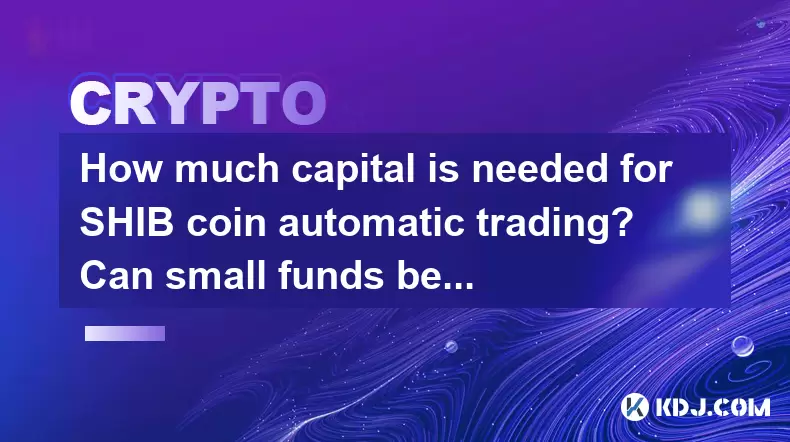-
 bitcoin
bitcoin $87959.907984 USD
1.34% -
 ethereum
ethereum $2920.497338 USD
3.04% -
 tether
tether $0.999775 USD
0.00% -
 xrp
xrp $2.237324 USD
8.12% -
 bnb
bnb $860.243768 USD
0.90% -
 solana
solana $138.089498 USD
5.43% -
 usd-coin
usd-coin $0.999807 USD
0.01% -
 tron
tron $0.272801 USD
-1.53% -
 dogecoin
dogecoin $0.150904 USD
2.96% -
 cardano
cardano $0.421635 USD
1.97% -
 hyperliquid
hyperliquid $32.152445 USD
2.23% -
 bitcoin-cash
bitcoin-cash $533.301069 USD
-1.94% -
 chainlink
chainlink $12.953417 USD
2.68% -
 unus-sed-leo
unus-sed-leo $9.535951 USD
0.73% -
 zcash
zcash $521.483386 USD
-2.87%
How much capital is needed for SHIB coin automatic trading? Can small funds be used for quantitative trading?
Small funds can be used for SHIB coin automatic trading, but careful risk management and strategy are crucial for success. Start small and scale up gradually.
May 20, 2025 at 07:35 am

When considering entering the world of automatic trading with SHIB coin, one of the primary concerns for many is the amount of capital required to start. Automatic trading, also known as algorithmic trading, involves using computer programs to buy and sell cryptocurrencies based on predefined criteria. This method can be particularly appealing for SHIB coin due to its high volatility and potential for quick profits. However, the question remains: how much capital is needed, and can small funds be effectively used for quantitative trading?
Understanding the Basics of SHIB Coin Automatic Trading
SHIB coin, or Shiba Inu, is a decentralized cryptocurrency that has gained significant attention in the crypto community. Automatic trading of SHIB coin involves setting up algorithms that can execute trades based on market conditions, technical indicators, or other predefined rules. The capital required for such trading can vary widely depending on several factors, including the trading strategy, the platform used, and the trader's risk tolerance.
Factors Influencing Capital Requirements
Several key factors influence the amount of capital needed for SHIB coin automatic trading:
Trading Strategy: Different strategies require different levels of capital. For instance, a high-frequency trading strategy might require more capital to cover transaction costs and potential losses, while a long-term strategy might require less initial capital but more patience.
Platform Fees: The trading platform you choose will have its own fee structure. Some platforms charge a percentage of each trade, while others might have a flat fee. These fees can eat into your capital, so it's essential to consider them when calculating your initial investment.
Risk Management: Effective risk management is crucial in automatic trading. This includes setting stop-loss orders and determining the size of each trade relative to your total capital. A well-managed portfolio can operate with less capital, as it minimizes the risk of significant losses.
Market Volatility: SHIB coin is known for its high volatility, which can be both a blessing and a curse. While it offers the potential for high returns, it also increases the risk of substantial losses. More capital might be needed to weather the ups and downs of the market.
Can Small Funds Be Used for Quantitative Trading?
The good news is that small funds can indeed be used for quantitative trading, including with SHIB coin. However, there are some considerations to keep in mind:
Leverage: Many trading platforms offer leverage, which allows traders to control a larger position with a smaller amount of capital. While leverage can amplify gains, it also increases the risk of significant losses. It's crucial to use leverage cautiously and understand the potential risks.
Scalability: With smaller funds, it's essential to focus on strategies that can be scaled up as your capital grows. This might mean starting with a conservative approach and gradually increasing your exposure as you gain confidence and experience.
Diversification: Even with limited funds, diversification can help manage risk. Instead of putting all your capital into SHIB coin, consider spreading it across different cryptocurrencies or assets to reduce the impact of any single loss.
Setting Up Automatic Trading with Small Funds
If you're interested in setting up automatic trading with SHIB coin using small funds, here's a step-by-step guide to get you started:
Choose a Trading Platform: Select a platform that supports SHIB coin and offers automatic trading capabilities. Popular options include Binance, Coinbase Pro, and Kraken. Consider the fees, user interface, and available tools when making your choice.
Develop or Acquire a Trading Algorithm: You can either develop your own trading algorithm or purchase one from a reputable source. If you're new to programming, there are many pre-built algorithms available that can be customized to your needs.
Fund Your Account: Deposit your small funds into your chosen trading platform. Start with an amount you're comfortable losing, as there's always a risk in trading.
Set Up Your Algorithm: Configure your algorithm with the parameters you want to use. This might include setting entry and exit points, stop-loss orders, and other risk management tools.
Backtest Your Strategy: Before going live, backtest your algorithm using historical data to see how it would have performed in the past. This can help you refine your strategy and increase your confidence.
Monitor and Adjust: Once your algorithm is live, monitor its performance closely. Be prepared to make adjustments as market conditions change or as you gain more experience.
Managing Risks with Small Funds
When trading with small funds, risk management becomes even more critical. Here are some tips to help you manage risks effectively:
Use Stop-Loss Orders: These orders can help limit your losses by automatically selling your position if the price drops to a certain level.
Avoid Overtrading: With small funds, it's tempting to make frequent trades to try and increase your returns. However, this can lead to higher transaction costs and increased risk.
Keep Learning: The cryptocurrency market is constantly evolving, so it's essential to stay informed and continue learning about new strategies and market trends.
Start Small: Begin with a small portion of your capital and gradually increase your exposure as you gain confidence and experience.
Real-World Examples of Small Fund Trading
There are numerous examples of traders successfully using small funds for quantitative trading. For instance, some traders have started with as little as $100 and gradually built their portfolios through careful strategy and risk management. These success stories highlight the potential for small funds to grow over time, provided the trader is disciplined and patient.
Tools and Resources for Small Fund Traders
Several tools and resources can help small fund traders succeed in automatic trading with SHIB coin:
Trading Bots: Platforms like 3Commas and Cryptohopper offer trading bots that can be customized to trade SHIB coin based on your strategy.
Educational Resources: Websites like CryptoQuant and Coinigy provide valuable insights and data that can help inform your trading decisions.
Community Forums: Engaging with other traders on platforms like Reddit and Telegram can provide support and new ideas for your trading strategy.
Frequently Asked Questions
Q: Can I use a demo account to practice automatic trading with SHIB coin?A: Yes, many trading platforms offer demo accounts that allow you to practice automatic trading without risking real money. This can be an excellent way to test your strategies and gain experience before using real funds.
Q: How do I know if my trading algorithm is performing well?A: You can assess the performance of your trading algorithm by tracking metrics such as the profit and loss (P&L), the win rate, and the drawdown. Regularly reviewing these metrics can help you determine if your strategy is effective and where adjustments might be needed.
Q: Are there any specific risks associated with trading SHIB coin?A: Yes, SHIB coin is known for its high volatility, which can lead to significant price swings. Additionally, as a relatively new cryptocurrency, it may be more susceptible to market manipulation and liquidity issues. It's essential to be aware of these risks and incorporate them into your trading strategy.
Q: Can I automate my trading strategy without coding?A: Yes, many platforms offer user-friendly interfaces that allow you to set up automatic trading strategies without writing code. Tools like TradingView and some trading bots provide drag-and-drop functionality to create and customize your algorithms.
Disclaimer:info@kdj.com
The information provided is not trading advice. kdj.com does not assume any responsibility for any investments made based on the information provided in this article. Cryptocurrencies are highly volatile and it is highly recommended that you invest with caution after thorough research!
If you believe that the content used on this website infringes your copyright, please contact us immediately (info@kdj.com) and we will delete it promptly.
- GeeFi Unleashes Game-Changing Staking with Up to 55% High-Yield APR for GEE Holders
- 2025-12-21 09:35:02
- Fiji's Currency Gets a Fresh Look: New Polymer Designs and Enhanced Circulation
- 2025-12-21 06:55:01
- Cathie Wood's Ark Invest Adjusts Tesla Investment, Eyes Crypto Opportunities
- 2025-12-21 06:45:02
- Navigating the New Frontier: Crypto Tax Bill, Stablecoins, and De Minimis Rules Take Center Stage
- 2025-12-21 03:35:01
- COIN's Compass: Coinbase Stock Market Performance Charting New Territories Amidst Evolving Crypto Landscape
- 2025-12-20 12:45:01
- GeeFi Rockets Towards 100x Returns, While Ripple Makes Strategic Stablecoin Moves
- 2025-12-20 06:15:02
Related knowledge

The Ultimate Guide to Navigating Your First Crypto Bull Run
Dec 04,2025 at 02:00pm
Understanding the Crypto Bull Run Cycle1. A bull run in the cryptocurrency market is characterized by a sustained increase in asset prices, often driv...

An Investor's Primer on Bitcoin and Digital Assets
Dec 05,2025 at 07:59pm
Understanding Bitcoin and Its Role in Modern Finance1. Bitcoin emerged in 2009 as the first decentralized digital currency, operating on a peer-to-pee...

The Definitive Guide to Cryptocurrency for Beginners in 2025
Dec 11,2025 at 12:00pm
Understanding the Basics of Cryptocurrency1. Cryptocurrency is a form of digital or virtual currency that relies on cryptography for security and oper...

Everything You Need to Know About Crypto Before Investing
Dec 09,2025 at 04:19pm
Understanding the Basics of Cryptocurrency1. Cryptocurrency is a digital or virtual form of currency that uses cryptography for security and operates ...

The Ultimate Guide to Your First Year in Crypto
Dec 17,2025 at 10:00pm
Your First Steps into the Crypto World1. Entering the cryptocurrency space begins with understanding the foundational concept: blockchain technology. ...

A Simple, No-Nonsense Guide to Cryptocurrency
Dec 18,2025 at 02:40pm
What Is Cryptocurrency?1. Cryptocurrency is a digital or virtual form of money that uses cryptography for security and operates independently of a cen...

The Ultimate Guide to Navigating Your First Crypto Bull Run
Dec 04,2025 at 02:00pm
Understanding the Crypto Bull Run Cycle1. A bull run in the cryptocurrency market is characterized by a sustained increase in asset prices, often driv...

An Investor's Primer on Bitcoin and Digital Assets
Dec 05,2025 at 07:59pm
Understanding Bitcoin and Its Role in Modern Finance1. Bitcoin emerged in 2009 as the first decentralized digital currency, operating on a peer-to-pee...

The Definitive Guide to Cryptocurrency for Beginners in 2025
Dec 11,2025 at 12:00pm
Understanding the Basics of Cryptocurrency1. Cryptocurrency is a form of digital or virtual currency that relies on cryptography for security and oper...

Everything You Need to Know About Crypto Before Investing
Dec 09,2025 at 04:19pm
Understanding the Basics of Cryptocurrency1. Cryptocurrency is a digital or virtual form of currency that uses cryptography for security and operates ...

The Ultimate Guide to Your First Year in Crypto
Dec 17,2025 at 10:00pm
Your First Steps into the Crypto World1. Entering the cryptocurrency space begins with understanding the foundational concept: blockchain technology. ...

A Simple, No-Nonsense Guide to Cryptocurrency
Dec 18,2025 at 02:40pm
What Is Cryptocurrency?1. Cryptocurrency is a digital or virtual form of money that uses cryptography for security and operates independently of a cen...
See all articles









































































